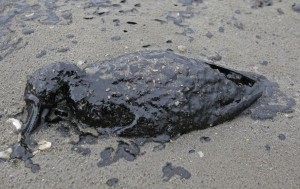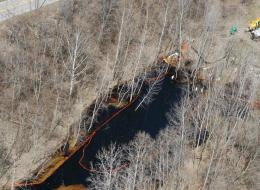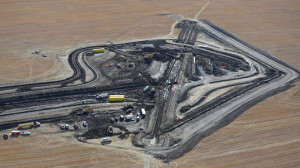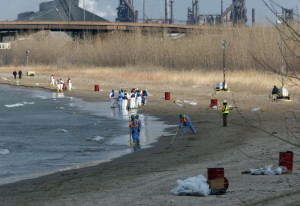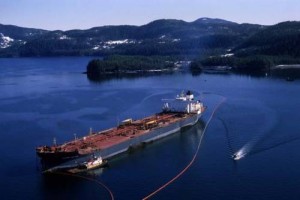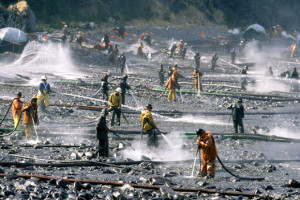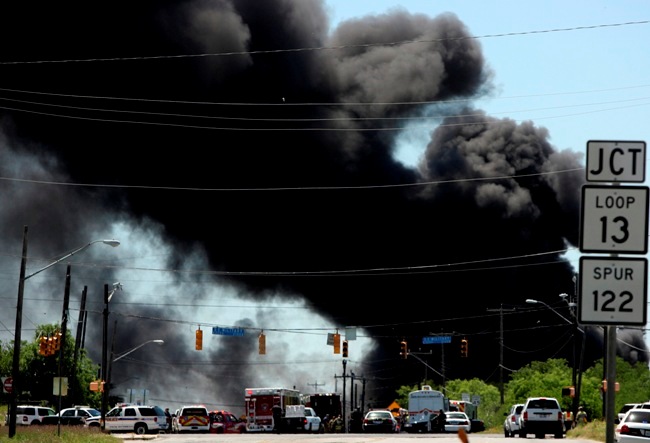This is a guest submission by Riki Ott, PhD. Dr. Ott is a marine toxicologist, author, and former commercial fisher. She was one of the first people on the scene during the Exxon Valdez oil spill, when millions of gallons of crude oil were discharged into the pristine waters of Prince William Sound, Alaska. For 23 years, she has been the voice and face of efforts for justice.
She is the featured character in the award-winning film BLACK WAVE: The Legacy of the Exxon Valdez, a documentary that tells the tale of the battle between commercial fishers against the largest corporation in the world, Exxon-Mobil.

In oil disaster after oil disaster, industry has repeatedly hidden the truth from federal agencies and the public about spill volume and extent of damages, including wildlife kills, ecosystem harm, and harm to worker and public health. This underreporting is done to minimize the spiller’s liability – often billions of dollars are at stake. If the oil industry is not held accountable for these costs, the costs are externalized and borne by the environment, local economies and businesses that depend on a healthy environment, individuals and families who suffer health consequences, and U.S. taxpayers.
Riki Ott, PhD is asking the press to pose critical questions rather than regurgitate industry press releases. The public depends on the press in order to be well informed and make important decisions. It is essential for the media to search for deeper explanations and more accurate information during incidents that threaten human health, wildlife, and the environment––and future energy choices.
Dr. Ott is offering this guide, based on her on-the-ground first-hand experience with the nation’s largest oil tanker spill (Exxon Valdez, 1989), offshore oil rig disaster (BP Deepwater Horizon, 2010), and on-land pipeline tar sands spill (Enbridge, 2010).

WHEN WAS THE LEAK DISCOVERED?
Exxon says the leak was discovered on Friday afternoon. What are residents saying? People living nearby should have known immediately from the fumes when the leak occurred or once it spilled above ground. In the case of the Enbridge tar sands oil spill in the Kalamazoo River (July 2010), residents reported smelling and seeing oil two days prior to the date Enbridge claimed the spill occurred.
WHAT KIND OF OIL WAS SPILLED?
Media is reporting a crude oil or sour crude spill. This oil is sour (containing high concentrations of hydrogen sulfide) but more importantly, it is heavy bitumen crude – tar sands oil (sour by nature) that has been diluted with lighter petroleum distillates and other very toxic chemicals.1 These chemicals are often labeled proprietary due to their toxic nature.
WHAT ARE OTHER NAMES FOR TAR SANDS OIL?
“Tar sands oil” is a political red flag, so the industry also calls it “nonconventional oil,” “heavy bitumen crude,” “dilbit” (diluted bitumen), and more recently, “sour oil,” and “sour crude”. Don’t fall for it. What spilled is the essentially the same stuff that Enbridge spilled in Michigan (July 2010) and that would be coming down the Keystone XL: tar sands oil (bitumen crude oil) with diluents, or dilbit.
WHAT ARE THE HUMAN HEALTH RISKS OF EXPOSURE TO TAR SANDS OIL, DILUENTS, AND DILBIT?
Common symptoms of exposure to conventional crude oil spills are well known and established within the medical community and include respiratory problems, central nervous system dysfunction, blood disorders, and skin problems.2 Unfortunately, a body only has so many ways to say it’s ill and the symptoms for chemical illnesses mimic those for colds/flu, asthma, bronchitis, COPD, bad headaches, vertigo, dizziness, tingling feet and hands, fatigue, general malaise, immune suppression (sick all the time), bad looking skin rashes like MRSA, peeling palms and soles of feet (for people walking barefoot), ear and nose bleeds (gushers), bleeding hemorrhoids, and more.3
Tar sands oil is concentrated with heavy hydrocarbons, known as Polycyclic Aromatic Hydrocarbons (PAHs) or more commonly as ultrafine particles. Exposure to PAHs can cause the health issues listed above (and also listed as compensable injury on BP medical benefits settlement4)––and similar injury in wildlife.5
The diluents are industrial solvents, containing petroleum distillates and other toxic chemicals that that target and harm the same organs of the body as PAHs/oil––the respiratory system, central nervous system, skin, and blood. This means the body takes a double hit of toxic chemicals. Diluents contain chemicals that are teratogens (disturb development of or kill babies in the womb), carcinogens, mutagens, systemic poisons, and cause hemolysis (rupture of blood cells). Some people are more vulnerable than others to dilbit, especially children6, pregnant women, elderly, African Americans, and those with pre-existing illnesses.7 Diluents are industrial solvents and degreasers, like dispersants, that act as an oil delivery mechanism, pulling oil into the body. The emerging science from the BP Gulf disaster is finding that chemically-dispersed oil is more toxic than oil alone to wildlife and humans.
Since tar sands oil is concentrated with PAHs and VOCs/diluents, dilbit is far more toxic to humans and animals (wild and domestic) than conventional oil. The oil industry (and government) are trying to downplay the human health risks of exposure to tar sands and/or dilbit because this is extremely politically inconvenient information. It nonetheless is extremely dangerous.
WERE RESIDENTS INFORMED OF THESE HEALTH RISKS? PROPERLY EVACUATED?
No. Residents and the city are being misinformed about health risks. A recent statement released by Exxon said, “The air quality does not likely present a human health risk, with the exception of the high pooling areas, where clean-up crews are working with safety equipment.”
This is simply not true. Oil and petroleum distillates (ingredient of both dispersants and diluents) wrecked havoc with wildlife and people in the aftermath of the BP disaster8 and the Exxon Valdez disaster.9 Similarly, tar sands oil and diluents made people sick in Michigan,10 where residents of one trailer court and neighborhood along the oiled riverbank blame exposure to tar sands oil and fumes for illness outbreaks including eighteen deaths––and counting.11 Oil and diluents can cause short- and long-term harm to health if people are not forewarned (educated about chemical illnesses, exposure, symptoms, and treatment) and given protection.
Dilbit has a mandatory 1,000-foot evacuation zone. Was it uniformly enforced? In Michigan, people in richer areas were evacuated while people in poorer areas were either not evacuated or were forced to relocate when the city condemned public housing units.12 Enbridge housed workers in some of the homes it purchased, raising health concerns. If the home wasn’t safe for the original occupants, why was it safe for the workers? Unprotected workers and the general public are at risk of exposure and chemical illness. Children, elderly, pregnant women, people with pre-existing illnesses, and African Americans, in particular, and domestic animals should have been evacuated immediately.
The local department of health should issue Public Health Advisories, warning residents of the signs and symptoms of exposure, such as headaches, nausea, vomiting, dizziness, nose bleeds, and cold- and flu-like symptoms, among others. Occupational and environmental medicine (OEM) doctors should be on hand to diagnose and treat illnesses that family doctors are not trained to recognize. These specialty physicians should NOT be provided by the industry; the city should hire them and ask industry for reimbursement. People should be given baseline health exams before returning to homes they evacuated; their homes should be tested for air quality. Wood and fabric, for example, absorb oily fumes and will off-gas over time. The industry should pay if homes, furniture, clothes, carpet, toys, etc., need to be replaced.
WERE THE CLEANUP CREWS GIVEN AND WEARING ADEQUATE PERSONAL PROTECTIVE EQUIPMENT?
Photos from KTHV in Little Rock, AR, show backhoe operators and others with absolutely no protective gear at all. Compare what the cleanup crews are wearing with what EPA and other federal responders were wearing, especially during the early response. During the Michigan response, EPA crews wore respirators and Hazmat gear. Hazmat crews with protective equipment and workers or the general public without similar protection in the same area is a sign of trouble for unprotected persons – and disingenuous PR statements. In Prince William Sound, Alaska, Alyeska’s SERVS workers are trained, provided with, and required to wear personal protective equipment, including respirators, during oil spill response.
WHAT HAPPENS WHEN DILBIT AND/OR TAR SANDS OIL GETS IN CITY SEWERS?
Photos from KTHV in Little Rock, AR, show dilbut bubbling down into storm sewers. City wastewater treatment facilities are not designed to process and remove even small amounts of oil. Individuals are fined hefty amounts for releasing even a quart of oil into sewers. Tar sands oil is thick, sticky goo and the diluents are extremely toxic chemicals. ExxonMobil needs to detail how it plans to help municipalities clean out the sewers and the wastewater treatment system––without contaminating the city’s water supply. If it is too late to avoid contamination of the city’s water supply, how will industry provide safe water for city residents?
ARE TAR SANDS OIL AND DILBIT MORE CORROSIVE THAN CONVENTIONAL OIL?
Yes. Period. No debate. Bitumen blends are more acidic, thick, and sulfuric than conventional crude oil. DilBit contains 15–20 times higher acid concentrations and 5–10 times as much sulfur as conventional crudes. The additional sulfur and high concentrations of chloride salts cause corrosion that weakens and ages pipelines, especially when dilbit is pumped under high temperature and pressure. Tar sands crude oil also contains high quantities of abrasive quartz sand particles, much more than used by liquid sandblasters. (Keystone XL pipeline maximum capacity would mean over 125 pounds of quartz sand and alumino-silicates per minute. Common sandblasters use between 1.5 and 47 pounds of sand per minute.) Conventional crude oil does not contain quartz sand particles. Dilbit is also up to 70 times more viscous than conventional crude.13
Not surprisingly, tar sands pipeline spills occur more frequently than spills from pipelines carrying conventional crude oil because of diluted bitumen’s toxic, corrosive, and heavy composition. Between 2007 and 2010, pipelines transporting diluted bitumen in the northern Midwest spilled three times more oil per mile than the national average for conventional crude oil. Between 2002 to 2010, internal corrosion caused over 16 times as many pipeline spills per 10,000 miles in Alberta, Canada, where pipelines transport mostly dilbit, than in the US, where pipelines transport mostly conventional crude oil. Finally, in its first year, the U.S. section of Keystone 1, carrying diluted tar sands oil, had a spill frequency 100 times greater than the TransCanada forecast. In June 2011, federal pipeline safety regulators determined Keystone 1 was a hazard to public safety and issued TransCanada a corrective action order.14
WHY DOES INDUSTRY CLAIM THERE IS SO LITTLE RISK? WHO PAYS THE COST OF SPILLS?
The oil industry is aware of the higher risk of spills from transporting dilbit and the higher cost of spill response, based on the Enbridge tar sands spill in Michigan. To minimize liability, industry lobbyists successfully argued that dilbit was not conventional oil and therefore exempt from the Oil Spill Liability Trust Fund. Oil shippers pay into this fund, which is then used by the federal government for spill response. Now the shippers most likely to spill oil, those shipping diluted tar sands oil, do not pay into the fund. But the fund is still tapped for spill response. If the fund goes bankrupt, U.S. taxpayers would foot the bill––on top of the annual $375 million subsidy for saving the oil and gas industry from paying into the fund in the first place.15
WHAT DOES THE PRESS NEED TO DO?
The government and industry are pushing the press away from these scenes with claims of safety concerns. Really? Are the media crews different from the workers or residents? The media could obtain and wear the same safety gear worn by the federal responders, if this is truly government’s concern. The BP Gulf disaster set horrible precedent for media access16––and the media acquiesced instead of insisting upon, and fully exercising, their First Amendment rights. THE MEDIA IS NOT GETTING THE FULL STORY IF THEY ARE DENIED ACCESS TO THE SPILL SITE––and neither are the American people.
- The ExxonMobil tar sands oil spill is very inconvenient for government, Congress, and industry. The U.S. State Department is taking public comment for the Keystone XL Pipeline until April 22. There will be a huge push by industry and the government to shut down the true risks and costs of transporting tar sands oil as inconvenient truths. It is the media’s job to accurately research and portray these risks to the public. In-depth research and reporting on the ExxonMobil tar sands spill in Arkansas would be a good start.

ENDNOTES:
1 Lisa Song, A Dilbit Primer: How It’s Different from Conventional Oil, June 26, 2012, http://insideclimatenews.org/news/20120626/dilbit-primer-diluted-bitumen-conventional-oil-tar-sands-Alberta-Kalamazoo-Keystone-XL-Enbridge
2 Barry Levy and William Nassetta, The Adverse Health Effects of Oil Spills, Intern. J. of Occupational Health and Environ. Medicine, 17(2):161– Apr/Jun, 2011. http://www.ncbi.nlm.nih.gov/pubmed/21618948
3 See: series of Huffington Post blogs documenting emerging public health epidemic of chemical illnesses across the oil-impacted Gulf Coast at: http://www.huffingtonpost.com/riki-ott/; See also: on-line version of Sound Truth and Corporate Myths at: www.rikiott.com under reading for medical professionals.
4 BP-Plaintiffs Medical Benefits Class Action Settlement Agreement, Exhibit 8: Specified Physical Conditions Matrix, Table 1: Acute SPECIFIED PHYSICAL CONDITIONS, and Table 3: Chronic SPECIFIED PHYSICAL CONDITIONS. http://www.laed.uscourts.gov/OilSpill/4.pdf
5 Charles Peterson, Stanley Rice, Jeffrey Short, Daniel Esler, James Bodkin, Brenda Ballachey, and David Irons, “Long-term Ecosystem Responses to the Exxon Valdez Oil Spill,” 2003; 302:2082–2086. See also Riki Ott, Sound Truth and Corporate Myths: The Legacy of the Exxon Valdez Oil Spill (Dragonfly Sisters Press, Cordova, AK: 2004), available at: www.rikiott.com
6 http://globalaccessmedia.org/consequence-oil-part/
7 Sciencecorps, 2010, Gulf Oil Spill Health Hazards. http://www.sciencecorps.org/Gulf_Spill_Chemical_Hazards_Report.pdf
8 Dahr Jamail, “Gulf seafood deformities alarm scientists,” Aljazeera English, April 20, 2012, http://www.aljazeera.com/indepth/features/2012/04/201241682318260912.html; BP blamed for ongoing health problems,
http://www.aljazeera.com/indepth/features/2012/04/2012420725163795.html
9 Kim Murphy, LA Times, November 5, 2001. http://groups.yahoo.com/group/EVOS/message/33
10 Martha Stanbury et al., Acute Health Effects of the Enbridge Oil Spill, Lansing, MI: Michigan Department of Community Health, November 2010, http://www.michigan.gov/documents/ mdch/enbridge_oil_spill_epi_report_with_cover_11_22_10_339101_7.pdf; Dahr Jamail, “Pipeline of ‘poison’,” Aljazeera English, Oct. 17, 2011. http://www.aljazeera.com/indepth/features/2011/10/2011101151776808.html
11 Michelle BorlandSmith, Jackson, MI, pers. communication.
12 Michelle BorlandSmith, Jackson, MI, pers. communication.
13 NRDC et al., Tar Sands Pipeline Safety Risks, June 2011, on p. 6, http://www.nrdc.org/energy/files/tarsandssafetyrisks.pdf
14 Cornell University Global Labor Institute, The Impact of Tar Sands Pipeline Spills on Employment and the Economy, March 2012, http://www.ilr.cornell.edu/globallaborinstitute/research/upload/GLI_Impact-of-Tar-Sands-Pipeline-Spills.pdf
15 Erin O’Sullivan, “Toxic and tax exempt,” Oil Change International, April 2, 2013, http://www.earthisland.org/journal/index.php/elist/eListRead/how_tar_sands_spills_from_michigan_to_arkansas_cost_us_all/; Oil Change International et al., “Irrational exemption: Tar sands pipeline subsidies and why they must end,” May 14, 2012, http://ecowatch.com/2012/tar-sands-industry-remains-exempt-from-spill-liability-fund/ and http://priceofoil.org/wp-content/uploads/2012/05/Irrational-exemption_FINAL_14May12.pdf
16 http://www.nola.com/news/gulf-oil-spill/index.ssf/2010/07/media_boaters_could_face_crimi.html
Read Full Post »
